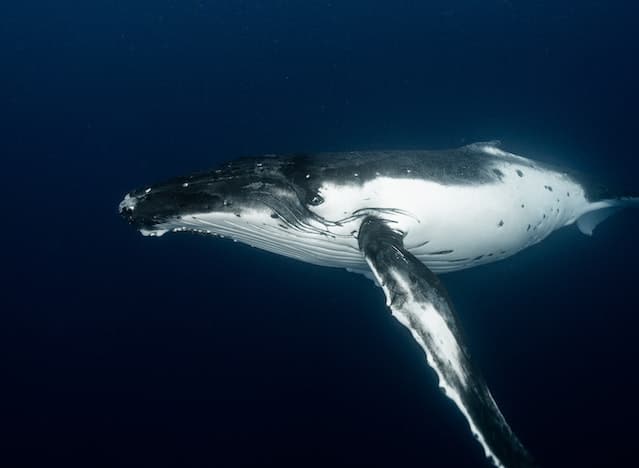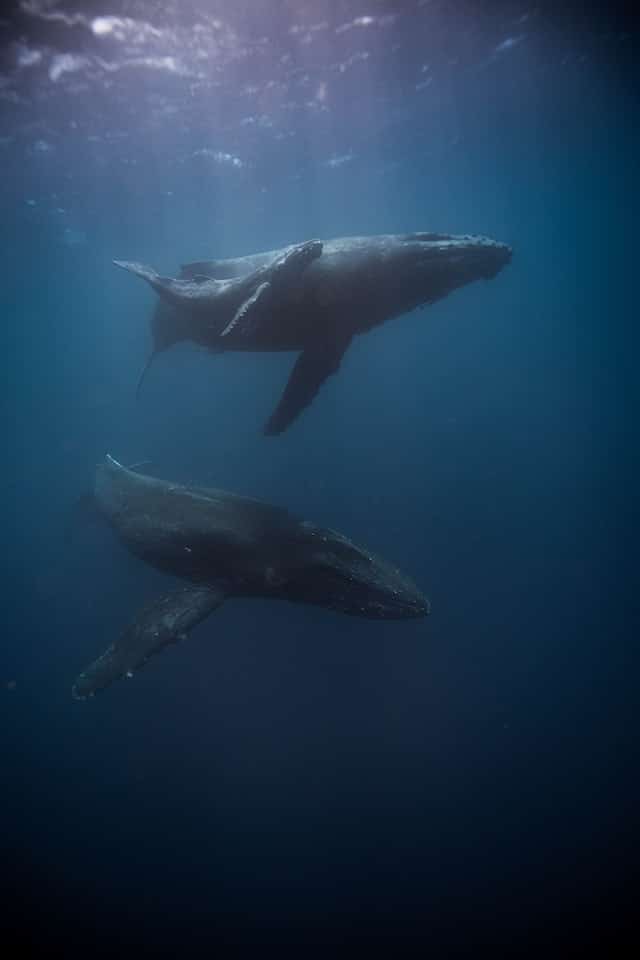Song of the Sea – Amazing facts about the sound of whales and dolphins

High-pitched squeaks, vibrating basses, sonorous calls and even bizarre clicks – all these sounds add up to a marine symphony like from another planet. They are used by cetaceans (that is whales, dolphins, and porpoises) for various purposes. Thanks to them, our marine friends can inform about their presence, attract a potential mate, stun their “food-to-be”, communicate with their kin, and even… see. In this article, I will discuss the various functions of the cetacean voice and some interesting facts about it.
Music from the deep – the sound of whales
While all cetaceans are capable of making sounds, only a few can sing. In the vocal field, the definite king of the depths is the humpback whale, whose males produce rhythmic songs with even entire musical phrases and verses. They last from a few to several dozen minutes, but can be repeated for up to 20 hours without a break! The songs of humpback whales are most likely used to summon a mate. There are other theories to explain the vocal performances of humpback whales, one of which is that the whales use their singing to mark their territory and keep competing males out of their way. Another theory looks for hidden information in whale songs. Not only males are capable of producing sounds – females and even baby whales do too, but only males can be called poets of music. Their songs evolve over time, are passed on between populations, and individuals may introduce modifications inspired by the melodies of their kins.
Submarine hit list
We like to think that many aspects of culture are only about us, humans. However, if you look closely at nature, you will find plenty of examples that this is not true. A good example would be fashion – more specifically fashion for a specific musical piece. It is not just people who are obsessed with the latest hits. Also among whales, every now and then, a particular song becomes extremely popular, spreading quickly throughout the seas, and finally a whole choir of humpback whales hums it even in very distant areas of the oceans. The speed at which humpback whales’ new hits spread across a vast territory continues to amaze scientists. It also demonstrates the ability of cetaceans to teach acquired skills and learn from each other – that is, passing on a culture that people like to consider only their own domain.

Whale language
While we can associate certain types of whale sounds with specific behaviors, we do not understand the meaning of individual phrases. The structure of cetacean language may also have nothing to do with the structure of our human languages. It is probably pointless to look for what we call words and sentences – maybe instead of it we should look for tones expressing particular emotions? We are far from understanding how these fascinating creatures communicate, but we do know that they speak different dialects. Whales of the same species present in the waters of the Pacific Ocean “speak” differently than in the waters of the Atlantic. In certain cases even neighboring populations may have difficulties in understanding each other. Three distinct pods of killer whales (orcas) from the North Pacific are a good example. Although they live next to each other and speak the same language, they use different dialects that are incomprehensible to their neighbors.
Transoceanic telephone
Deep under water, you can’t see much – if you can see anything. For this reason, cetaceans rely more on their sense of hearing than sight. They use their hearing to explore their surroundings, search for food, and to receive information sent by their relatives, cousins, and even by distant populations or completely different species. Whales make sounds to inform about their presence. They just like to know where others are, although they are not necessarily looking for them. That’s why the ocean keeps echoing with “phone calls” from one cetacean to another and back again. Since sound travels much further in dense water than it does in air, whale calls can be eavesdropped on even from very long distances.
A sound out of nowhere
It would seem that it is simple: sound is produced in the larynx by so-called vocal cords, thanks to the air that makes them vibrate. That is how it works in humans. But not in whales! Marine mammals are large – we can’t examine them with X-ray or magnetic resonance, and therefore we do not know exactly how individual organs of these animals function. The most astounding thing, however, is that when the whales sing, no air comes out of their mouths at all! Instead, cetaceans produce sound by passing pressurized air back and forth through the larynx and numerous sinus cavities in their skull. This allows them to sing and communicate without losing the precious air they need to breathe underwater.

Ears to the world
Underwater visibility dramatically decreases with each meter of depth. However, cetaceans spend their entire lives in water, sometimes diving to great depths in search of food. Here the record belongs to Cuvier’s beaked whale, which can dive nearly 3,000 meters deep! But how can you see where you’re swimming, where the obstacles are, and even more so where the predator is lurking or… where the dinner is hidden? The answer – thanks to the sound of whales, or echolocation. This ability consists in emitting sounds enabling orientation in space thanks to the echo that returns to the sender.
Echolocation occurs in both toothed whales and baleen whales, but there is an important difference between the two groups. In toothed whales, echolocation is a highly developed adaptation and takes place at the ultrasonic level (very high tones). In baleen whales, the infrasonic range (very low tones) is used, but echolocation is much less important, mainly due to a different way of feeding. Toothed whales prey on restless fish and other mammals, so the ability to pinpoint prey precisely is crucial to their survival. Baleen whales, on the other hand, filter out huge amounts of microscopic plankton suspended in water, which is why highly developed echolocation is unnecessary for them, and the sounds they produce are mainly used for communication.
Hit it and eat it!
Many species of cetaceans hunt using echolocation to figure out their surroundings and to track prey, but is its only function? When the stomach contents of certain dolphin species were searched, it turned out that the fish found in them did not show any teeth marks. In addition, today’s toothed whale species are rather modestly equipped for hunting compared to fossil ones – their teeth are relatively small and sometimes blunt. Does it mean that some cetaceans do not need to use their teeth to feed? According to some researchers, it can be concluded that the ability of echolocation in toothed whales evolved not only as a kind of “eyes”, but also to become their deadly weapon. The animals use their biosonar to produce loud impulses, likely to stun or even kill the fish, which are then swallowed whole.

The sound of whales that knocks you off your feet
The fact that toothed whales can use sound as a weapon is completely unsurprising when you find out about the sperm whale’s vocal abilities. This largest toothed whale in the world, and at the same time the largest toothed predator, is also the loudest living creature on our planet. To give you a better idea of the scale: the sound of a human conversation is around 50 decibels, the human pain threshold is 120 dB, the sound of a jet taking off is about 140 dB, and the lethal threshold for our species is 180 dB. The innocent “clicks” of sperm whales reach an astonishing value of 230 decibels and are able to “vibrate” a person to death. I think I will reconsider my dream of diving with sperm whales…
Dear human
There are known examples of captive orcas and beluga whales showing the ability to imitate human speech. According to scientists, this proves the strong need of these animals to communicate with us. Cetaceans have a completely different vocal mechanism than humans, so it probably takes a lot of effort to imitate our speech. Of course, cetaceans are not the only animals able to imitate the human voice – such a phenomenon is commonly observed in birds, for example. However, the vocal apparatus of birds is much better adapted to this, moreover, these animals naturally use imitation as a means of social communication or to attract attention. The imitation of human speech by cetaceans is so unusual that it must testify to great determination. And if so, what are our “finned” friends trying so hard to tell us…?
Cetaceans are fascinating creatures in many ways. Their high intelligence and outstanding vocal abilities leave a wide field for research for scientists. Understanding the language of whales is an extremely difficult task, but even Egyptian hieroglyphs were once deciphered. One thing is certain: the sustainable lifestyle of cetaceans, their social interactions, sophisticated way of communication and important role in the functioning of the earth’s ecosystem have much to teach us.
Source of images: Pexels.com
Authors: Elianne Dipp, Adam Ernster, 7inchs, Daniel Torobekov

